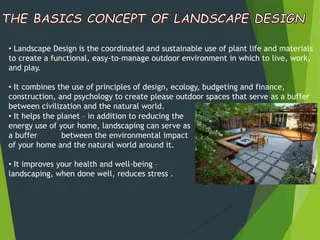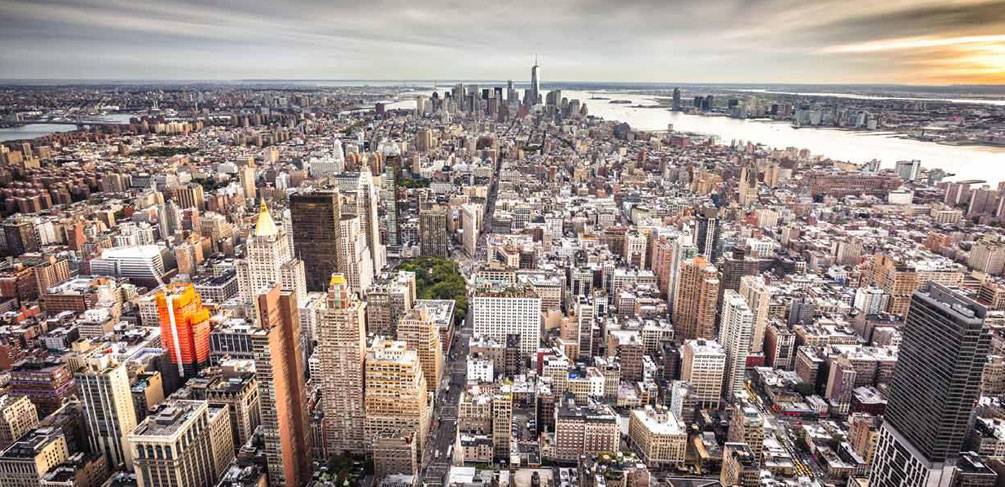Rumored Buzz on Landscape Design
Table of ContentsA Biased View of Landscape DesignExamine This Report on Landscape DesignAll about Landscape DesignThe Basic Principles Of Landscape Design
A lawn can usually be separated right into 3 locations: public (the front backyard), exclusive (the back backyard), and service (usually the side yard). The area of activity locations depends primarily on the type of location, the dimension of room needed, the kind of task, and the wanted closeness to other activities and frameworks.
The outdoors wall of the home frequently works as the very first wall or beginning factor of an outdoor area. Incompatible uses ought to be separated, and associated tasks, such as cooking and eating, must be put with each other to make the yard more effective and pleasurable. When using hardscape to develop areas, use building and construction material similar to that utilized in your home for continuity from your house into the yard.
Linked spaces. Credit Scores: Gail Hansen, UF/IFAS Utilizing similar hardscape features and repeating plants draws the eye around the yard.
From a layout perspective, plant products have three significant features in the landscape: visual, structural and practical. Visually, plants create an aesthetically pleasurable atmosphere and structurally plants organize and define rooms.
The Best Guide To Landscape Design
For emotional convenience plants are utilized as physical or suggested barriers for personal privacy and safety and security. Physical obstacles obstruct both the view and access to a space and consist of fencings, wall surfaces and plant hedges. Landscape Design. Indicated barriers, typically reduced expanding plants, block access yet not the view (Figure 9). Other functions of plants consist of cleansing the air, avoiding disintegration and dirt loss, retaining wetness in the soil, and returning raw material to the dirt.
Physical and implied obstacles. Credit: Gail Hansen, UF/IFAS For these reasons, the kinds of plants to be utilized (such as trees, bushes, or groundcovers) need to be picked in the beginning of planning. Plant kinds are selected for their useful abilities to ensure that their future function and needed area can be thought about at the same time.
The above plane, the upright airplane and the ground plane need to all be thought about to produce enclosure. Once the form of a plant bed has been established, the plants must be massed (organized) my review here and split to accomplish aesthetic unity and the preferred quantity of enclosure. The dimension of a plant mass will certainly rely on the total dimension of the lawn, the size of the individual plants in the mass, and the focus or influence wanted from the plant product.
Each plant mass remains in front of, behind, or beside, one more mass. Number 11. Horizontal plant layers. Credit Scores: Gail Hansen, UF/IFAS Figure 12. Upright plant layers. Credit Rating: Gail Hansen, UF/IFAS Duplicating plants within a mass and repeating masses with comparable plants ties the garden with each other. The individual plant attributes need to be thought about to efficiently layer and mass plants.
Some Known Details About Landscape Design
All plant structures start with the main framework plants, the big, mainly evergreen history plants-such as the trees and big shrubs. These plants different or enframe spaces, regulate the size of the space, and provide the beginning point for selecting the appropriate characteristics of the 2nd layer, midground plants, for massing and infill.
Important points in the garden must be highlighted by the usage of special plants, unique structures, or garden accessories. Noting thresholds or entrances to spaces can be made with entrances, arbors, and actions, or through making use of unique and colorful plants. this article The form and/or style theme of the yard will certainly often aid figure out the important factors and how they should be highlighted.
Various other important areas in the lawn are focal points, which is used to aesthetically arrange a landscaped location. Different point of views or point of views can expose different compositions in the landscape that may need a variety of focal points.
The 25-Second Trick For Landscape Design
Number 13. Plant forms. Credit: Gail Hansen, UF/IFAS After form, texture is the following dominant function of a plant; rugged, medium and great textures can be used for contrast and emphasis in the landscape. Kind and appearance both trump shade in the garden for the majority of the year. However, throughout specific periods, shade will be the most recognizable feature of the garden.


The pleasant fragrance of plants, the noise of wind in the trees, the sound and appearance of water, and the shades like this and textures of sculptures, pots and yard furniture all contribute to the experience of the yard. One information that is typically ignored is the result of light on the appearances of the plants.
The whole garden modifications in function and look over the training course of the day, and the program of a year, as the light and temperature level change from morning to night and period to period. Plant option should take into consideration a plant's development rate, its fully grown size and form, and the upkeep it will certainly call for.
It is necessary to recognize the ultimate mature size of plants so they can be positioned in the right place and spaced correctly when they are installed. Offering plants room to grow is a difficulty because the usual fully grown size is usually based upon optimal expanding conditions and the environmental conditions of a website may cause a plant to enlarge or stay smaller sized.